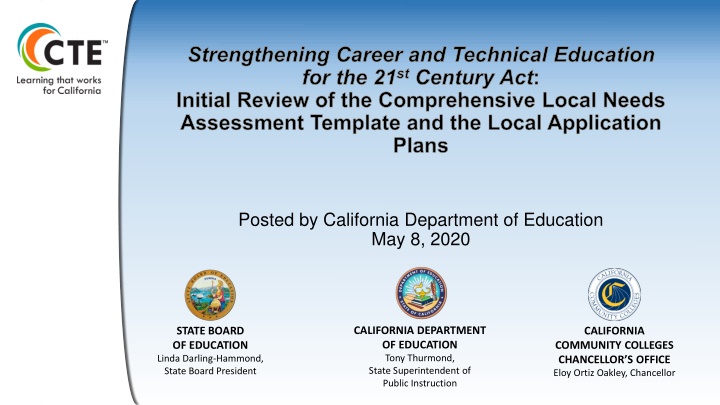
Strengthening Career and Technical Education: CLNA Components and Stakeholder Representation
Explore the Comprehensive Local Needs Assessment (CLNA) components and the importance of stakeholder representation in strengthening Career and Technical Education for the 21st Century. Learn about requirements, implementation, and progress towards equity and access as mandated by Perkins V Law.
Download Presentation

Please find below an Image/Link to download the presentation.
The content on the website is provided AS IS for your information and personal use only. It may not be sold, licensed, or shared on other websites without obtaining consent from the author. If you encounter any issues during the download, it is possible that the publisher has removed the file from their server.
You are allowed to download the files provided on this website for personal or commercial use, subject to the condition that they are used lawfully. All files are the property of their respective owners.
The content on the website is provided AS IS for your information and personal use only. It may not be sold, licensed, or shared on other websites without obtaining consent from the author.
E N D
Presentation Transcript
Strengthening Career and Technical Education for the 21stCentury Act: Initial Review of the Comprehensive Local Needs Assessment Template and the Local Application Plans Posted by California Department of Education May 8, 2020 CALIFORNIA DEPARTMENT OF EDUCATION Tony Thurmond, State Superintendent of Public Instruction STATE BOARD OF EDUCATION Linda Darling-Hammond, State Board President CALIFORNIA COMMUNITY COLLEGES CHANCELLOR S OFFICE Eloy Ortiz Oakley, Chancellor
Presentation Overview Comprehensive Local Needs Assessment (CLNA) Template Local Application Plan 2
Components of the Local Application Process Assurances Stakeholders State Determined Performance Levels Comprehensive Local Needs Assessment (CLNA) Budget Builder Budget Viewer Local CTE Program Changes Update Signature Authorization 3
Typical Submission Process for Local Application Released in February to the local recipients Initial Submission to College and Career Transition Division (CCTD) in May Review and comment by CCTD staff in June Local Recipient signoff and filing at CDE Local Plan activated July 1 What is new under Perkins V is CLNA 4
Member Comments Members, Please use the Raise Hand feature in Zoom which can be found in the Participant tab. Staff will call your name so you can your comment. Please remember to place yourself on mute after you have completed your comment. 5
CLNA Components Perkins V Law requires local recipients address the following: disaggregated student performance; alignment to labor market information; requirements for sufficient size, scope, and quality; implementation of programs and programs of study; recruitment, retention, and training of teachers, faculty, and staff; and progress toward improving access and equity. 6
CLNA Stakeholder Representation Create a stakeholder group from the following: representatives of CTE programs representatives of postsecondary CTE programs; representatives of local workforce development boards and local or regional businesses or industries; parents and students; representatives of special populations; representatives serving out-of-school youth, homeless children and youth, and at-promise youth; representatives of Indian Tribes and Tribal organizations; and any other necessary and related stakeholders. 7
CLNA Process (1) Required to be collected every two years Conduct the CLNA in the following manner for each element using template: Collect data and information Identify Needs Develop Strategies 8
CLNA Process (2) Validation by stakeholder group Review of all elements data, needs, and strategies Include a summary report in Local Application 9
Member Comments (2) Members, Please use the Raise Hand feature in Zoom which can be found in the Participant tab. Staff will call your name so you can your comment. Please remember to place yourself on mute after you have completed your comment. 10
Components of the Local Application Process (2) Assurances Stakeholders State Determined Performance Levels Comprehensive Local Needs Assessment (CLNA) Budget Builder Budget Viewer Local CTE Program Changes Update Signature Authorization 11
An Overview of the Local Application Process Perkins legislation always required a local application Started in one fiscal year and ended in the next Centered on new or improving existing high- quality CTE programs Plan should connect program, budget, and performance 12
How Local Application Information Validated Through the budget and expense reimbursement process Through annual review of local application plans, including CLNA Through CDE federal program monitoring 13
Summary Local Application is longstanding feature of federal Perkins legislation CLNA is new under Perkins V and required collection every two years State is requiring a summary of CLNA to be included within local application CLNA informs how local application is to be developed Different ways to assess fidelity of CLNA and local application process 14
Member Comments (3) Members, Please use the Raise Hand feature in Zoom which can be found in the Participant tab. Staff will call your name so you can your comment. Please remember to place yourself on mute after you have completed your comment. 15
Submission Timeline for Local Application (1) May15, 2020: Substantial Approvable Application Form Sent Out to Perkins V local recipients June 15, 2020: Completed Substantial Approvable Application Form retuned by Perkins V local recipients 16
Submission Timeline for Local Application (2) September 15, 2020: CDE receives on or before completed Local Application including CLNA summary December 15, 2020: CDE receives on or before the final Local Application with all revisions 17
Member Comments (4) Members, Please use the Raise Hand feature in Zoom which can be found in the Participant tab. Staff will call your name so you can your comment. Please remember to place yourself on mute after you have completed your comment. 18
Public Comment (3) Zoom Register at: https://zoom.us/webinar/register/WN_yg1DgFqYQzS8G_iTXWwUCg When logging into Zoom please use your first and last name to provide public comment. Email Path2Work@cde.ca.gov and include the following: 1) your name; 2) your affiliation, if any; 3) the agenda item number (i.e., Item 01); and 4) your public comment. Phone 712-432-0075, Access Code: 651905# Press *6 during the public comment period to be added to the queue. 19
